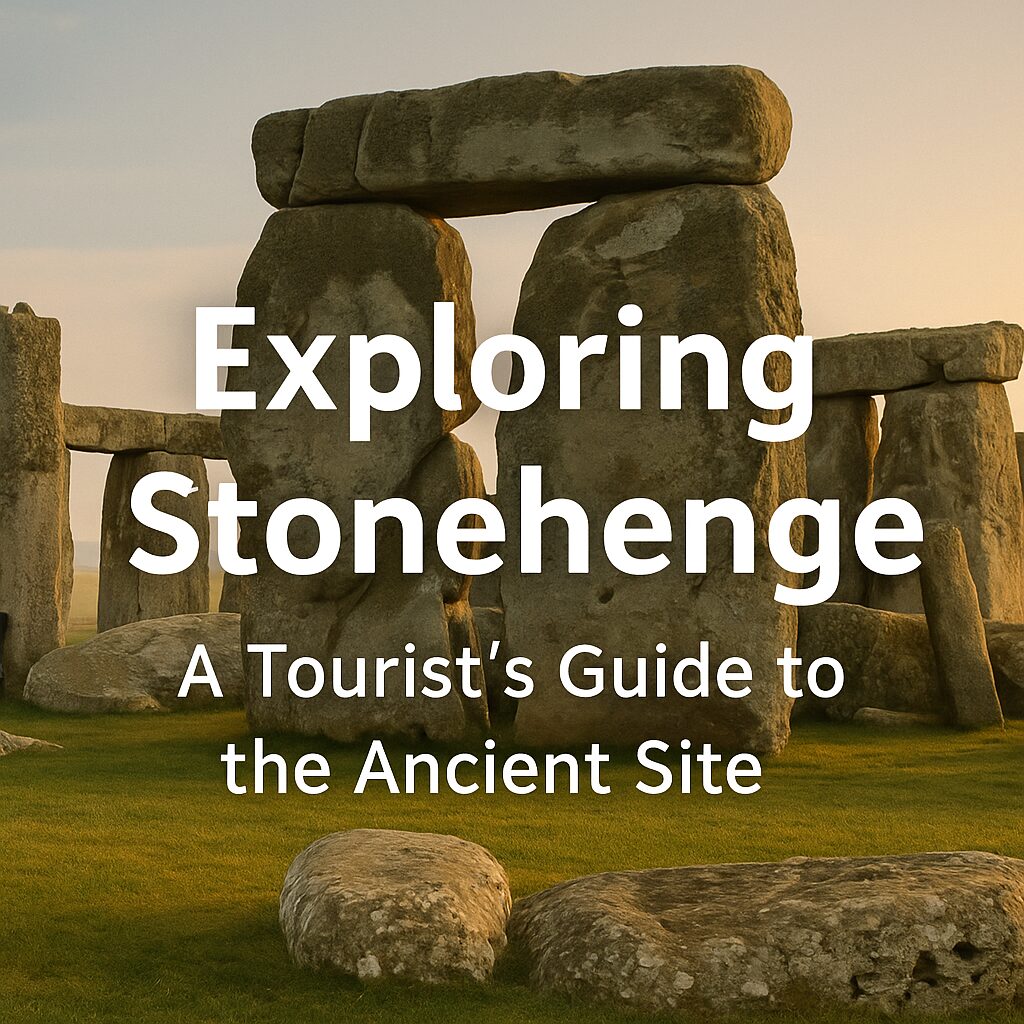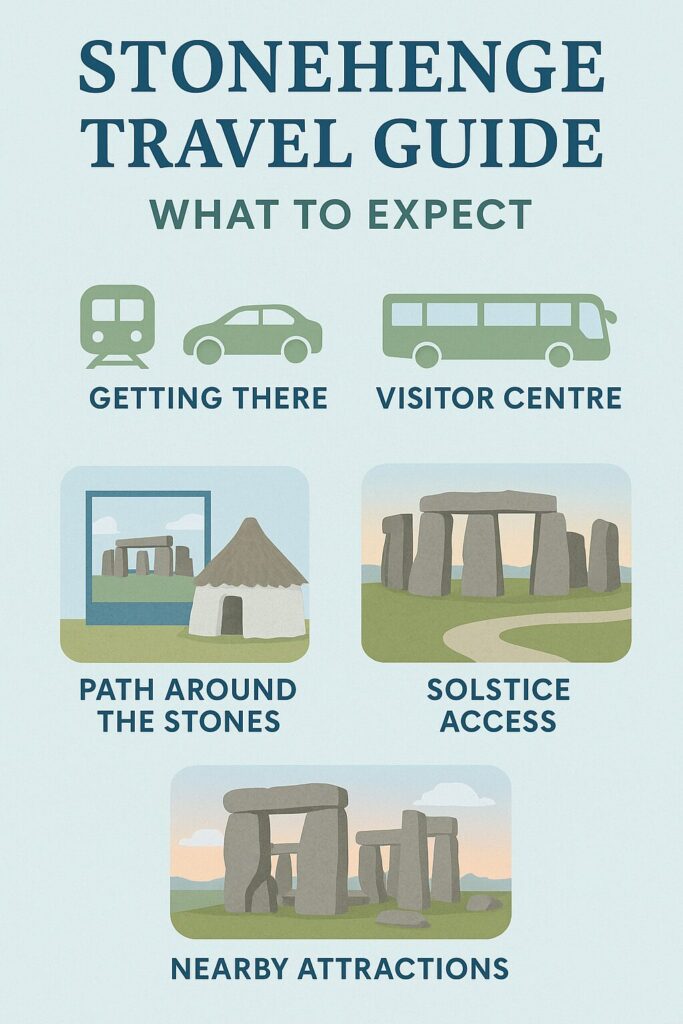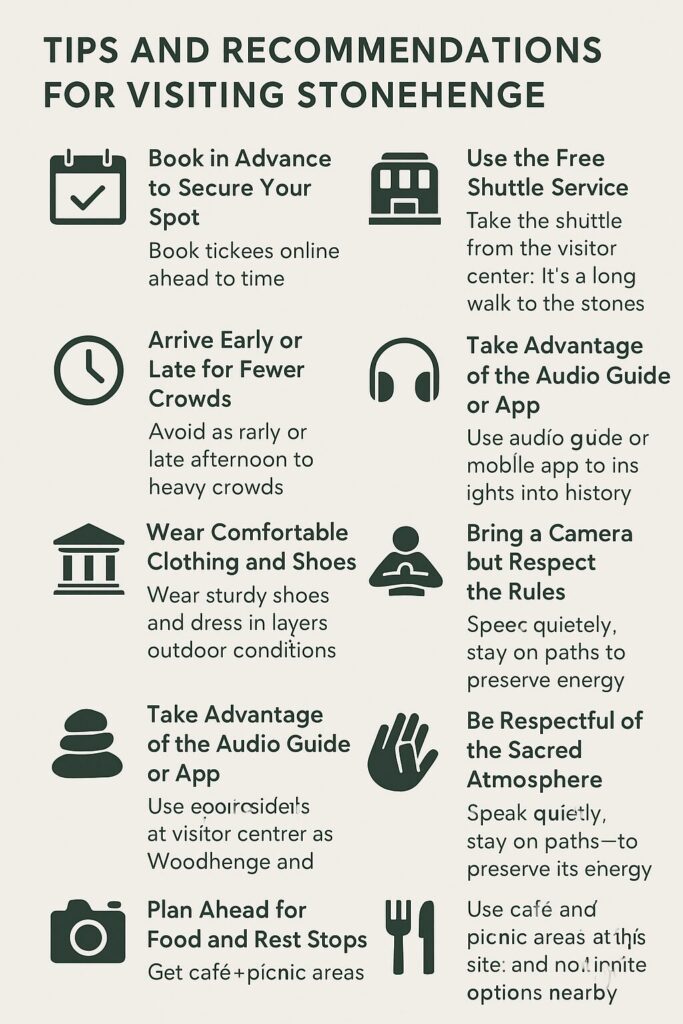
Discover everything you need to know before visiting Stonehenge with this complete tourist guide. Learn about its mysterious origins, must-see highlights, visitor tips, and travel info to make the most of your trip to this ancient wonder.
Contents
- Introduction: Exploring Stonehenge – A Tourist’s Guide to the Ancient Site
- Exploring Stonehenge: A Tourist’s Guide to the Ancient Site
- What is Stonehenge?
- How to Get to Stonehenge
- What to Expect During Your Visit
- Theories and Legends About Stonehenge
- Paranormal and Supernatural Beliefs
- Best Times to Visit Stonehenge
- What to Bring and Wear
- Nearby Attractions
- Conclusion: The Magic of Stonehenge Awaits
- Final Thoughts
- Tips and Recommendations for Visiting Stonehenge
- Frequently Asked Questions About Visiting Stonehenge
- 🔗 Reference Websites for Exploring Stonehenge
Introduction: Exploring Stonehenge – A Tourist’s Guide to the Ancient Site
Stepping Into the Mystery of Stonehenge
Stonehenge is more than just a circle of stones in the English countryside. It’s one of the most iconic and mysterious ancient monuments in the world.
Located on the Salisbury Plain in Wiltshire, England, this prehistoric site has fascinated travelers, historians, and spiritual seekers for centuries.
From its massive standing stones to its perfectly aligned solstice points, Stonehenge continues to spark curiosity about who built it, why, and how.
As a visitor, you’re not just looking at ancient rocks, you’re stepping into a place where time, nature, and ancient human effort all converge.
This guide will walk you through everything you need to know about visiting Stonehenge.
Whether you’re planning a solo trip or a family adventure, we’ll cover essential tourist tips, historical insights, and what to expect on your journey to this UNESCO World Heritage Site.
Why Stonehenge Captures the World’s Attention
For thousands of years, Stonehenge has been a symbol of mystery, wonder, and ancient knowledge. Historians believe it was built in several stages, beginning around 3000 BCE.
While its exact purpose remains unknown, theories range from an ancient burial ground to a solar calendar, and even a site for spiritual rituals.
Its unique construction, astronomical alignments, and massive stones—some transported over 150 miles—make it one of the greatest architectural feats of the ancient world.
Today, Stonehenge draws millions of visitors each year who come to experience its powerful energy and historical significance.
Many travelers report feeling awe-struck while standing near the towering sarsens and bluestones.
With each visit, people walk away with different perspectives, some intrigued by the science, others moved by the spiritual connection, and many simply amazed by the mystery that continues to surround this sacred site.
What This Tourist Guide Will Help You Discover
Planning your visit to Stonehenge can be exciting but also a bit overwhelming. This tourist guide will help you get the most out of your experience.
From how to get there and when to visit, to ticket information and insider tips, you’ll have everything you need to explore Stonehenge with confidence.
We’ll also share must-see features, nearby attractions, and photography spots to make your trip unforgettable.
You’ll also gain insights into the legends, folklore, and ancient history that make Stonehenge such a unique destination.
Whether you’re a history buff, spiritual explorer, or casual traveler, this guide will help you connect with the site in a meaningful way.
Let’s begin your journey into the heart of England’s most iconic ancient landmark—Stonehenge.
Watch this quick guide for complete planning advice—from arrival logistics to must‑see Stonehenge highlights.
Exploring Stonehenge: A Tourist’s Guide to the Ancient Site
Introduction: Unlocking the Secrets of Stonehenge
Stonehenge is one of the most mysterious and visited ancient monuments in the world.
Located in the open fields of Wiltshire, England, this prehistoric stone circle continues to captivate travelers, historians, and those drawn to the paranormal.
Whether you visit for its ancient history, spiritual energy, or the unexplained forces believed to surround the site, Stonehenge offers a unique experience you will never forget.
For many visitors, stepping onto the grounds of Stonehenge feels like crossing into another realm.
The silence of the stones, the way they align with the sun during the solstices, and the deep-rooted legends passed down over centuries create an atmosphere unlike any other.
This guide will help you prepare for your trip, explore the history behind the stones, and dive into the myths, theories, and practical tips to make the most of your visit.
What is Stonehenge?
How Old is Stonehenge and Why Was it Built?
Stonehenge is over 5,000 years old and was built in several phases between 3000 BCE and 2000 BCE. While its exact purpose remains unknown, experts believe it was used for astronomical tracking, rituals, and burials. The monument’s alignment with the solstices suggests it held spiritual or ceremonial importance.
A Monument Shrouded in Mystery
Stonehenge is a circular arrangement of standing stones, some weighing over 25 tons, placed with incredible precision.
Archaeologists believe the site was built in stages between 3000 BCE and 2000 BCE.
It was likely used for rituals, astronomy, and burial purposes. The true reason for its construction remains unknown.
Many believe Stonehenge is more than a historical landmark. It may have been a spiritual center, an astronomical observatory, or a portal for supernatural forces.
The energy felt at Stonehenge is hard to describe, but many visitors report a strange sense of calm, awareness, or connection with something greater.
Key Facts About Stonehenge
- Location: Wiltshire, England
- Estimated Age: Over 5000 years old
- UNESCO World Heritage Site since 1986
- Aligns with the sunrise on the summer solstice
- Made of Sarsen stones and smaller Bluestones
How to Get to Stonehenge
How to visit Stonehenge from London?
To visit Stonehenge from London, travelers can drive (approx. 2 hours via M3 and A303), take a train to Salisbury followed by a shuttle, or book a guided bus tour. Booking tickets in advance is recommended to secure entry slots and avoid crowds.
Travel Options
Visiting Stonehenge is easy with several transport options from major cities in the UK.
- By Car: From London, drive west on the M3 and A303, about 2 hours.
- By Train: Take a train from London Waterloo to Salisbury. From Salisbury, buses and taxis go directly to the site.
- By Tour Bus: Many companies offer day trips from London or Bath.
Tips for Travelers
- Arrive early to avoid crowds.
- Book your tickets in advance online.
- Wear comfortable walking shoes. The site is outdoors and spread out.
- Bring a jacket or umbrella. English weather is often unpredictable.

What to Expect During Your Visit
Visitor Center Experience
Before reaching the stone circle, you will start at the Stonehenge Visitor Centre. This modern facility features exhibitions, ancient artifacts, and interactive displays that explain the monument’s history and mystery.
You can explore a recreated Neolithic village to see how the builders of Stonehenge may have lived. There is also a large gift shop, café, and shuttle service to the stones themselves.
Walking Around the Stones
Can you walk inside the Stonehenge stone circle?
General admission allows you to walk around the outside of the Stonehenge circle on a marked path. Special access tours, which require advance booking, let small groups enter the inner circle during sunrise or sunset, but visitors are still not allowed to touch the stones.
While visitors cannot touch the stones, you can walk a circular path around the monument.
This path gives you multiple viewpoints and photo opportunities. Informational signs are posted along the trail.
For those seeking a more spiritual or private experience, special access tours allow small groups to enter the inner circle during sunrise or sunset. These require advance booking and are highly recommended.
Theories and Legends About Stonehenge
What are some theories about Stonehenge’s purpose?
Theories about Stonehenge range from scientific to spiritual. Some believe it was an ancient solar calendar, while others think it was a burial ground or healing center. Legends also suggest it was built by Druids or extraterrestrials. Its alignment with celestial events supports the idea of ceremonial use.
Ancient Theories
Stonehenge has inspired countless theories, both scientific and mystical. Some experts believe it was used to track the sun and moon. Others think it was a burial ground for elite individuals.
Still, other researchers believe it had healing properties. The Bluestones, believed to be brought from Wales, were thought to have spiritual energy or power.
Paranormal and Supernatural Beliefs
Is Stonehenge a paranormal site?
Stonehenge is believed by many to be a site of strong energy fields and ancient power. Paranormal enthusiasts claim it lies on intersecting ley lines and has been linked to spiritual phenomena, ghost sightings, and even UFO activity. While not proven, its mystical aura draws spiritual seekers from around the world.
Many visitors claim to feel an energy field around the site. Psychics and spiritualists often visit Stonehenge to connect with what they believe are ley lines—energy paths that cross the Earth. Some say UFO sightings and ghostly figures have been reported near the monument.
Other popular beliefs include:
- Stonehenge as a Druid temple
- A portal to other dimensions
- Built with help from extraterrestrials
- A place of powerful spiritual rituals
These stories may not have scientific proof, but they keep the magic of Stonehenge alive in the minds of those who visit.
Best Times to Visit Stonehenge
When is the best time to visit Stonehenge?
The best time to visit Stonehenge is early morning or late afternoon to avoid crowds. Spring and summer offer great weather and greenery, while winter brings fog and a mystical atmosphere. Visiting during the solstices offers a unique experience but requires early planning.
Season and Weather
Spring and summer are the most popular times to visit. The weather is warmer, and the green fields around the stones make for incredible photos.
However, winter and fall offer quieter visits and a more mystical atmosphere. Fog often blankets the site during colder months, giving it an eerie and haunting beauty.
Solstice Celebrations
If you want to see Stonehenge at its most magical, attend a solstice event.
On the summer and winter solstices, the sun aligns perfectly with the stones. Thousands of people gather to witness the sunrise, celebrate, and soak in the spiritual energy.
These events are free but crowded. Arrive early and plan ahead if you want to take part.
What to Bring and Wear
What should I wear to Stonehenge?
Wear comfortable shoes for walking on uneven ground, and dress in layers to prepare for changing weather. A light jacket or raincoat is useful year-round, and sunglasses or sunscreen are essential during summer. Avoid sandals or open shoes on wet days.
Practical Essentials
- Comfortable walking shoes
- Water bottle
- Light jacket or raincoat
- Camera or phone for photos
- Sunscreen and sunglasses in summer
Optional Items
- Binoculars for distant views
- Notebook or journal to record your thoughts
- Travel guidebook
- Small offering or token if you’re doing a spiritual visit
Nearby Attractions
What are some other ancient sites near Stonehenge?
Other ancient sites near Stonehenge include Avebury Stone Circle, Woodhenge, Durrington Walls, and Old Sarum. These Neolithic and Bronze Age sites expand the Stonehenge story and are easily reachable by car or local tours.
Other Historical Sites
- Avebury Stone Circle: Another ancient monument that allows you to walk among the stones.
- Old Sarum: An ancient hill fort with a castle ruin and great views.
- Salisbury Cathedral: Home of one of the original Magna Carta copies.
Paranormal Hotspots
- Woodhenge: A lesser-known site near Stonehenge with a mysterious wooden post layout.
- The Rollright Stones: Located in Oxfordshire, known for legends of witches and curses.
Conclusion: The Magic of Stonehenge Awaits
Stonehenge is more than just a tourist destination.
It is a place where history meets mystery, and where the veil between the past and present feels thinner.
Whether you go for the history, the beauty, or the unexplained energy that surrounds the stones, your visit will be memorable.
Every person who visits Stonehenge walks away with a story. Some feel peace. Others feel awe.
Many leave with more questions than answers. That is the power of this ancient place.
Final Thoughts
If you’re ready to explore one of the most iconic ancient sites in the world, Stonehenge is waiting.
Come with curiosity, leave with wonder. Let the stones speak to you, and you may find something you never expected.
Whether you’re a history lover, a paranormal enthusiast, or just looking for an unforgettable day trip, this guide gives you everything you need to make the most of your journey.
Plan your visit, take your time, and open your mind. Stonehenge is not just a destination. It is an experience.
Tips and Recommendations for Visiting Stonehenge

1. Book in Advance to Secure Your Spot
Stonehenge is one of the most visited tourist attractions in the United Kingdom. It draws thousands of visitors every week, especially during the warmer months and solstice celebrations. To avoid disappointment, book your tickets online in advance through the official English Heritage website. Booking ahead allows you to choose your preferred time slot and guarantees entry, especially during busy seasons or holiday weekends. If you’re planning to join a special access tour or attend a sunrise or sunset viewing, these limited tickets often sell out weeks in advance.
2. Arrive Early or Late for Fewer Crowds
The best times to visit Stonehenge are early in the morning when the site first opens or later in the afternoon closer to closing time. Midday hours are often the busiest, especially in the summer. If you want a more peaceful and less crowded experience, plan to arrive as early as possible. Early arrivals also offer better lighting for photography, cooler temperatures for walking, and more opportunities to take in the ancient atmosphere without distractions.
3. Wear Comfortable Clothing and Shoes
Stonehenge is an outdoor attraction located in an open field. There is a lot of walking involved, from the visitor center to the shuttle drop-off point and the circular path around the stones. The terrain is mostly flat but can be uneven or muddy after rain. Wear comfortable, closed-toe shoes with good grip. Dress in layers and always bring a light raincoat or windbreaker, even in summer. The weather in Wiltshire can change quickly, and wind gusts across the plains are common.
4. Use the Free Shuttle Service
The shuttle bus from the Stonehenge Visitor Centre to the stone circle is included with your ticket and runs every few minutes. While the walk to the stones is scenic, it can be long for some visitors—nearly 1.5 miles each way. If you’re short on time, have mobility issues, or simply want to save your energy, the shuttle is the best option. You can walk one way and ride the shuttle back, or use it both ways depending on your preference.
5. Don’t Skip the Visitor Centre and Museum
Before heading to the stones, spend time at the Stonehenge Visitor Centre, where you’ll find exhibits, films, and ancient artifacts that tell the story of the monument’s origins. The museum offers a fascinating look at Neolithic tools, burial items, and how the massive stones were transported and erected. There’s also a life-size replica of a Neolithic house village, which gives insight into the daily life of the people who may have built Stonehenge. This context helps make the experience at the stone circle far more meaningful.
6. Take Advantage of the Audio Guide or App
English Heritage offers a free mobile app and downloadable audio guide for Stonehenge. These tools provide commentary, historical facts, spiritual interpretations, and folklore that you won’t get from signage alone. Bring headphones and use your phone to follow along during your visit. If you prefer not to use your phone, audio devices can be rented at the visitor center.
7. Visit Nearby Sites to Deepen Your Experience
Stonehenge is only part of the ancient landscape in the area. Expand your journey by visiting Woodhenge, Durrington Walls, and the Cursus Barrows—all located within a short distance. Each of these sites adds another layer to the mystery and helps paint a fuller picture of the people who lived and worshipped here. If you have a car or join a guided tour, make time to explore Avebury, which features the largest stone circle in Britain and allows visitors to walk directly among the stones.
8. Bring a Camera but Respect the Rules
Photography is allowed at Stonehenge, so bring your camera or smartphone to capture the moment. The site offers incredible angles during sunrise, sunset, and even in cloudy weather. However, drones are strictly prohibited without prior approval, and visitors are not allowed to cross barriers or touch the stones. If you want that iconic shot of the full circle, position yourself near the western viewing area for the best backdrop and lighting.
9. Be Respectful of the Sacred Atmosphere
While Stonehenge is a world-famous tourist site, it also holds deep spiritual and cultural meaning for many people. Druids, Pagans, and spiritual seekers continue to visit the site for ceremonies, meditations, and rituals. Even if you’re not spiritually inclined, treat the site with reverence. Speak quietly, respect the land, and do not litter or climb on any stones or mounds. Visitors often describe the feeling at Stonehenge as otherworldly, so give yourself a moment of silence to connect with its energy.
10. Plan Ahead for Food and Rest Stops
While the site has a small café that serves light meals, coffee, and snacks, options are limited. If you’re visiting with children, have dietary restrictions, or plan a longer stay, consider bringing your own picnic lunch. There are designated picnic areas near the parking lot. The nearest town, Amesbury, has restaurants and grocery stores. Make restroom stops before you head out to the stone circle, as there are no facilities beyond the visitor center.
Frequently Asked Questions About Visiting Stonehenge
What is the best time of year to visit Stonehenge?
The best time to visit Stonehenge depends on your goals. If you want pleasant weather and lush green scenery, plan your trip between late spring and early autumn (May through September). For fewer crowds and a more mystical experience, winter months can be ideal, especially around the winter solstice when fog often surrounds the stones, creating an eerie and powerful atmosphere.
Visiting during a solstice celebration (summer or winter) offers a once-in-a-lifetime experience, but expect large crowds and limited access unless booked early.
Do I need to book tickets in advance to visit Stonehenge?
Yes, it is highly recommended to book your Stonehenge tickets in advance. The site operates on timed entry slots, especially during peak tourist seasons. You can book online through the English Heritage website. Pre-booking ensures entry and can save you time waiting in line.
Special access tickets for sunrise or sunset visits to the inner circle also require advanced reservations and often sell out weeks in advance.
Can I touch the stones at Stonehenge?
In general, no. For preservation reasons, visitors must stay on a designated path around the stone circle. However, English Heritage offers limited Stone Circle Access experiences during early morning or evening hours. These allow small groups inside the circle, where you can walk among the stones under supervision, but still not touch them.This private access must be reserved in advance and comes with an additional fee.
How do I get to Stonehenge from London or other major cities?
There are several ways to reach Stonehenge:
- By Train: Take a direct train from London Waterloo to Salisbury Station (about 1 hour 30 minutes). From there, a shuttle bus or taxi can take you to the site (30 minutes).
- By Car: Stonehenge is approximately 90 miles west of London. Take the M3 and A303; the drive takes around 2 hours.
- By Tour Bus: Multiple companies offer guided day tours from London, Bath, or Oxford that include transportation, entrance fees, and sometimes other attractions.
Is Stonehenge wheelchair accessible?
Yes. The Stonehenge Visitor Centre and shuttle buses are fully accessible. While the path around the stones is gravel and grass, mobility scooters and wheelchairs are available. Special arrangements can be made with English Heritage in advance to accommodate visitors with limited mobility.
An accessible toilet and priority parking are also available on-site.
How long should I plan to spend at Stonehenge?
Most visitors spend two to three hours at the site. This includes time at the Visitor Centre, a walk through the museum exhibits, browsing the gift shop, and walking the full loop around the stone circle. If you’re taking part in a solstice event or a private inner circle tour, allow extra time. Nearby attractions like Woodhenge or Avebury can also extend your day trip.
Is Stonehenge part of a larger archaeological area?
Yes. Stonehenge is just one part of a much larger ancient landscape. The area includes burial mounds (barrows), processional avenues, Woodhenge, Durrington Walls, and nearby Avebury Stone Circle. This entire area is rich in Neolithic and Bronze Age history.
If you’re interested in archaeology or ancient spirituality, exploring the broader Stonehenge landscape will deepen your experience.
Are there any paranormal stories or legends connected to Stonehenge?
Absolutely. Stonehenge has long been associated with mysticism, energy fields, ley lines, and supernatural folklore. Many visitors report feeling strange sensations or spiritual energy near the stones. Some believe the monument was used for Druid rituals or even as a portal to other realms.
Legends also claim Stonehenge was built by Merlin the wizard or with the help of ancient aliens. While these stories may not be provable, they add to the magical and mysterious aura that surrounds the site.
Is Stonehenge suitable for children or family visits?
Yes. Stonehenge offers a family-friendly experience with educational exhibits, open green space, and an engaging visitor centre. Children can enjoy the interactive museum, see a recreated Neolithic village, and take part in seasonal events. However, since much of the site is outdoors, bring weather-appropriate clothing and snacks if visiting with younger children.
Can I bring food or drinks into Stonehenge?
Outside food and drinks are allowed in the outdoor areas, but not inside the Visitor Centre. There is an on-site café that serves hot meals, snacks, and beverages, including vegetarian and vegan options.
Picnic areas are also available near the parking lot and shuttle stop.
What should I wear when visiting Stonehenge?
Dress for the weather. The site is outdoors and exposed to wind, sun, or rain depending on the season. Wear:
- Comfortable walking shoes or boots\n- A waterproof jacket or windbreaker\n- A hat and sunglasses in summer\n- Layers during cooler months
Stonehenge is located in the English countryside, so expect some uneven ground and possibly muddy paths in wetter months.
If you’re fascinated by ancient mysteries, haunted history, and paranormal exploration, then Paraghosts.com is your ultimate destination.
Dive into in-depth articles, ghost hunting guides, spiritual phenomena, and the unexplained forces that shape our world.
Whether you’re a seasoned investigator or just beginning your journey into the unknown, Paraghosts delivers the tools, stories, and insights you need to explore the supernatural like never before.
Here’s a list of trusted reference websites related to Stonehenge, tourism, history, and paranormal research:
🔗 Reference Websites for Exploring Stonehenge
✅ Official & Historical Resources
- English Heritage – Stonehenge
https://www.english-heritage.org.uk/visit/places/stonehenge/
(Official site for visiting info, tickets, and history) - UNESCO World Heritage Centre – Stonehenge
https://whc.unesco.org/en/list/373
(Cultural heritage and conservation information) - Historic England – Stonehenge Landscape
https://historicengland.org.uk/listing/the-list/list-entry/1010140
(Detailed listing and protected status of the site) - National Trust – Stonehenge & Avebury
https://www.nationaltrust.org.uk/stonehenge-landscape
(Information about the surrounding landscape and walking trails) - British Museum – Neolithic and Bronze Age Collections
https://www.britishmuseum.org/collection
(Search Stonehenge-related artifacts and exhibitions)
🧭 Travel & Tourism Sites
- Visit Wiltshire
https://www.visitwiltshire.co.uk/things-to-do/stonehenge-p155313
(Travel tips, nearby attractions, and local accommodation) - Visit Britain – Stonehenge Guide
https://www.visitbritain.com/gb/en/stonehenge
(National tourism advice for travelers coming from abroad) - Tripadvisor – Stonehenge Reviews & Tips
https://www.tripadvisor.com/Attraction_Review-g209964-d189266-Reviews-Stonehenge-Amesbury_Wiltshire_England.html
(User reviews, travel experiences, and photography tips)
🌌 Paranormal, Mysticism, and Alternative Theories
- Ancient Origins – Stonehenge Archives
https://www.ancient-origins.net/tags/stonehenge
(Theories, folklore, and speculative research) - The Megalithic Portal
https://www.megalithic.co.uk
(Database of ancient and sacred sites, including Stonehenge
- Top 10 Most Haunted Hotels in America You Can Stay At - September 22, 2025
- What Is a Yeti? Unraveling the Himalayan Legend - September 20, 2025
- UAP vs UFO: Explaining the Key Differences and Why It Matters Today - September 19, 2025



